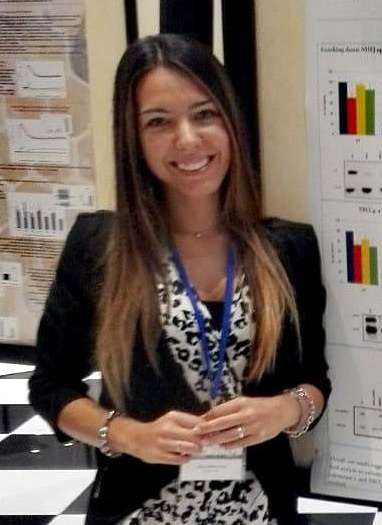
Elisa Mentegari
Istituto di Genetica Molecolare “Luigi Luca Cavalli-Sforza”
Via Abbiategrasso, 207 – 27100 PAVIA
tel: +39 0382 546355
E-mail: elisa.mentegari@igm.cnr.it
Curriculum Vitae – Download
Complete List of Publications – Download
Research Activity
Characterization of the role of repair DNA polymerases in Alternative Lengthening of Telomeres (ALT).
About 10% of cancers utilize ALT as telomeres maintaining mechanism (TMM). Despite some features common to ALT-proficient cells (e.g. abundant extrachromosomal telomeric repeat DNA (ECTR) and the presence of ALT-associated promyelocytic leukemia (PML) bodies (APBs)), ALT mechanism is not fully elucidated yet. Since TMM is considered a potential therapeutic target, the characterization of the molecular mechanism and of the enzymes participating to ALT could contribute to the identification of new pharmaceutical targets. In recent years, our group accumulated evidence supporting a role of specialized DNA repair enzymes in initiation of telomeres elongation during ALT. Finding an essential activity in ALT exerted by these factors will pave the way for the development of new therapies specifically targeting ALT + cancers.
- Mentegari, E. et al. A Role for Human DNA Polymerase λ in Alternative Lengthening of Telomeres. International Journal of Molecular Sciences, 2021
Characterization of a novel alternative end-joining pathway conferring resistance to anticancer drugs.
DNA double strand breaks (DBS) represent a threat for genome stability. Eukaryotic cells developed two main pathways to face DBS: Homologous Recombination (HR) and Non-Homologous End Joining (NHEJ). However, in cancer cells, unbalance of DNA repair pathways favors the emergence of new biochemical pathways for the repair of DSBs. Such Alternative End-Joining (A-EJ) pathways are associated to chemotherapy resistance and genetic instability, an essential feature for cancer progression. For these reasons, the elucidation of the factors involved in A-EJ pathways is important for the potential development of new chemotherapeutic treatments. We are now investigating the role of repair polymerases on an A-EJ emerging in ALT cells upon treatment with classic immunotherapeutic agents.
Ribonucleotides misincorporation by specialized DNA polymerases.
With more than 107 ribonucleotides (rNMPs) misincorporated in the human genome during replication, embedded rNMPs are the most abundant DNA lesions. The presence of the 2’-hydroxyl group makes misincorporated rNMPs prone to spontaneous hydrolysis, potentially resulting in the accumulation of strand breaks. Moreover, their presence may decrease the rate of DNA replication causing replicative fork stalling and, eventually, collapse. For these reasons, defects of RNase H2, the enzyme that initiated the Ribonucleotide Excision Repair pathway, are detrimental for the survival of living organisms. The aim of my work is to elucidate the impact of rNMPs misincorporation opposite different DNA lesions during TLS, as well as the effects of such mispairs on RER efficiency. Our findings supported the notion that DNA repair can be a relevant source of rNMPs accumulation. In particular, Pol b, rather than Pol l, could misincorporate rNMPs both during Base-Excision repair (BER) opposite normal DNA bases and during bypass of 8-oxo-G, the most abundant oxidazed nucleotide. Our data also suggested a potential role of Pol h in synthesizing long stretches of RNA, which may increase the toxicological consequences of rNMPs incorporation in cells with impaired RNase H2. Insertion of rNMPs opposite damaged bases may affect the work of specialized DNA glycosylases and/or reduce the efficiency of their removal by RNase H2, depending on the type of lesion.
- Mentegari E. et al. Ribonucleotide incorporation by human DNA polymerase η impacts translesion synthesis and RNase H2 activity. Nucleic Acids Research, 2017
- Crespan E. et al. Impact of ribonucleotide incorporation by DNA polymerases β and λ on oxidative base excision repair. Nature Communications, 2016
Research expertise
-
- Molecular biology
- Cellular biology, including mammalian, plant and bacterial cell cultures and immunofluorescence techniques
- Biochemistry, including recombinant protein expression and purification and set-up of in vitro assays
